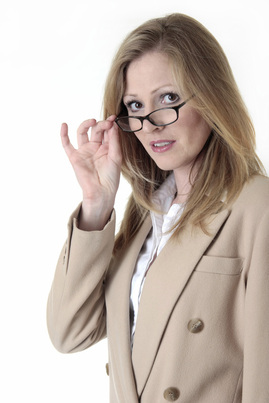
Hi there... I'm Julie O'Hara, and I've got another body language tip for you. (Lee Hanson is busy writing TOPAZ TRAP, my next murder mystery.)
Take a look at the photo on the left. An apt title might be, "What did you say?" What we have pictured here is a congruent group of gestures, a cluster: 1. a sideways glance, 2. head tipped slightly forward, and 3. lowered glasses.
(I would caution you to always look for "clusters". While it's true that a hand-to-the-nose gesture often signals a lie - the Pinocchio effect - remember that sometimes it just means an itchy nose!)
But I digress, back to the picture: This is a businesswoman, asserting herself with a prop... her eyeglasses.
Writers (like Lee) can use props like glasses to convey a picture of what's happening in a scene. Imagine an office underling who has screwed up an assignment and is called into the boss' office. There he sits, squirming in his chair:
1. While the boss across the desk peers at him over granny glasses, frowning. Ooh, not good.
2. Even worse, what if the boss stands up, throws the glasses on the desk and glares at him!
3. With luck, the boss might sit back, take the glasses off and put the tip of one of the earpieces in his mouth. Such a gesture says: "I'm listening, explain."
Pipes are great props, too. A fictional friend of mine, Sherlock Holmes, made good use of his pipe; cleaning it, tapping it, stoking it... all of which gave him thinking time to unravel a mystery. Lee Hanson has a prop, too: a computer. She's using it to stall like Sherlock, while she figures out my next mystery...
Julie (typed by Lee)
Take a look at the photo on the left. An apt title might be, "What did you say?" What we have pictured here is a congruent group of gestures, a cluster: 1. a sideways glance, 2. head tipped slightly forward, and 3. lowered glasses.
(I would caution you to always look for "clusters". While it's true that a hand-to-the-nose gesture often signals a lie - the Pinocchio effect - remember that sometimes it just means an itchy nose!)
But I digress, back to the picture: This is a businesswoman, asserting herself with a prop... her eyeglasses.
Writers (like Lee) can use props like glasses to convey a picture of what's happening in a scene. Imagine an office underling who has screwed up an assignment and is called into the boss' office. There he sits, squirming in his chair:
1. While the boss across the desk peers at him over granny glasses, frowning. Ooh, not good.
2. Even worse, what if the boss stands up, throws the glasses on the desk and glares at him!
3. With luck, the boss might sit back, take the glasses off and put the tip of one of the earpieces in his mouth. Such a gesture says: "I'm listening, explain."
Pipes are great props, too. A fictional friend of mine, Sherlock Holmes, made good use of his pipe; cleaning it, tapping it, stoking it... all of which gave him thinking time to unravel a mystery. Lee Hanson has a prop, too: a computer. She's using it to stall like Sherlock, while she figures out my next mystery...
Julie (typed by Lee)
 RSS Feed
RSS Feed